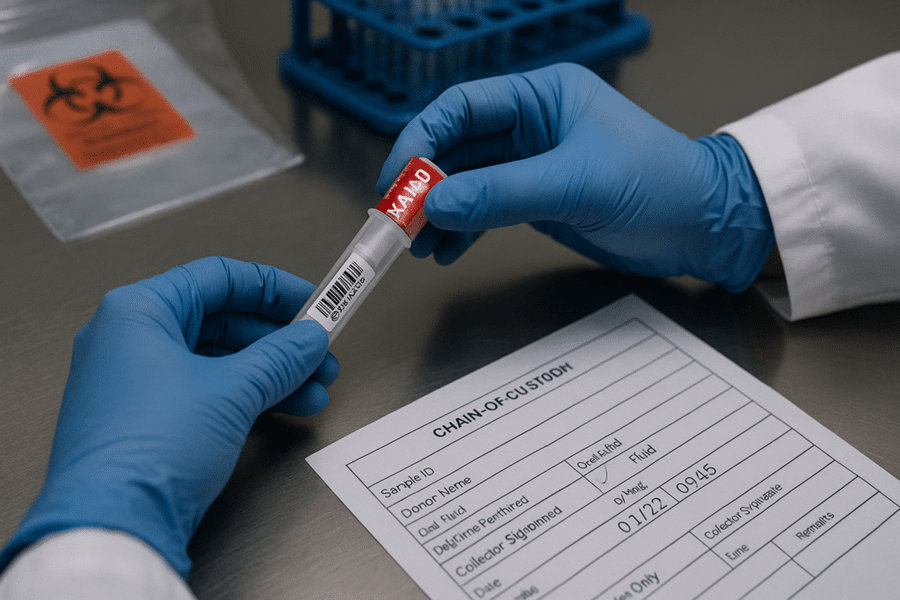
Saliva Drug Test
Introduction
A saliva drug test (also called an oral-fluid or mouth-swab test) is fast, non-invasive, and widely used by employers and clinicians to check very recent drug use.
In this guide, you’ll learn exactly what it detects, typical detection times (including THC), how lab timelines like Labcorp’s work, and where false positives are least likely.
We’ll also share a saliva drug test detection time table you can reference at a glance. You’ll see how results are confirmed, which cutoffs apply under federal guidance, and how oral fluid compares with urine and hair.
Finally, we address the common “how to pass” question in a safe, lawful way, focusing on what you can legitimately do—plus quick answers to the most asked FAQs.

What is a saliva drug test?
A saliva drug test collects a small sample of oral fluid by swabbing the inside of your mouth—usually in 1–3 minutes—and sends it to a lab for screening and confirmation when needed. Because drugs enter saliva quickly, oral fluid is a strong indicator of recent use.
Why employers and clinics use it
- Collected under direct observation (hard to tamper).
- Detects very recent use better than urine in many cases.
- Quick collection; fast lab turnaround.
What does a saliva drug test detect?
Panels vary, but common drug classes include:
- THC (cannabis)
- Cocaine
- Amphetamines & Methamphetamine
- Opioids/Opiates (e.g., morphine, heroin, oxycodone, fentanyl)
- Benzodiazepines
- PCP
(Alcohol and nicotine can be tested separately when needed.)

Saliva drug test detection times (overview)
Typical window: oral fluid detects many drugs within ~1 hour of use and for about 5–48 hours after last use, depending on the substance, dose, and route. This shorter window is why it’s favored for spotting recent exposure.
Labcorp saliva drug test detection times
Labcorp notes that many drugs appear in oral fluid in under an hour and may remain detectable for 5 to 48 hours after last use (longer is uncommon and depends on the drug and usage pattern). Negative screens often report in 24–36 hours after the lab receives the specimen; confirmations add time.
Saliva drug test THC detection window
THC in oral fluid typically reflects very recent cannabis use. Research shows median last detection around ~24 hours, with ranges from a few hours up to ~30–72 hours in some settings or heavier/frequent use. Rapid decline after the first hour is common as mouth contamination clears, but heavy or frequent use can extend positivity.
Key idea: Oral-fluid THC is best at indicating recent use, not long-past exposure.
Saliva drug test detection time table
Below are typical oral-fluid detection windows. Individual results vary with dose, frequency, cutoffs, metabolism, and device sensitivity.
| Drug / Class | Typical oral-fluid detection window* |
| THC (cannabis) | ~6–24 hours typical; may reach 30–72 hours in heavier use |
| Cocaine | ~24–36 hours |
| Amphetamines / Methamphetamine | ~24–48 hours |
| Opiates (morphine/heroin) | ~24–36 hours |
| Prescription opioids (e.g., oxycodone/fentanyl) | up to ~48 hours |
| Benzodiazepines | up to ~48 hours |
| Alcohol | up to ~24 hours |
*Summarized from clinical references and lab FAQs; exact timing depends on cutoffs, dose, use pattern, and device. See sources below.
Cutoffs, confirmation, and accuracy
Cutoffs (federal guidance). For federally regulated workplace testing, oral-fluid guidelines establish analyte-specific screening and confirmatory cutoffs (e.g., THC screening and confirmation in the low single-digit ng/mL range). These guidelines became effective Oct 10, 2023, and HHS maintains a list of certified laboratories for urine and oral fluid.
What that means for you:
- Lower cutoffs help detect recent use.
- Non-negative screens are confirmed by more specific methods before final reporting.
False positives and passive exposure:
- Oral fluid has less “poppy-seed” noise than urine because of its shorter window.
- Federal commentary emphasizes confirmation strategies (e.g., additional cannabinoid markers) to reduce passive-exposure positives.
How the collection works (step-by-step)
- No food, drink, or gum shortly before the test (per the collector’s instructions).
- A collector places a swab between cheek and gum or under the tongue until a volume indicator appears.
- The swab goes into a transport buffer and is sealed.
- The lab performs screening; any presumptive positives go to confirmatory testing.
Saliva vs. urine vs. hair: which is “best”?
- Saliva (oral fluid): Best for recent use; collection is observed and simple; window ~hours to 1–2 days for most drugs.
- Urine: Longer detection for many drugs (days to weeks for some metabolites), but less precise for very recent use and easier to adulterate.
- Hair: Longest historical window (weeks to months), not useful for recent use.
“How to pass a saliva drug test”: important legal & safety note
I can’t help with advice intended to cheat or evade a drug test. Providing tactics to “beat” a test is unsafe and may be illegal or a violation of workplace policy. Here’s what you can legitimately do:
- Abstain: The only reliable way to “pass” is not using drugs prior to testing.
- Disclose prescriptions: Bring documentation for any legally prescribed medications that could explain a positive; a Medical Review Officer (MRO) may contact you to verify.
- Follow instructions: Avoid food, drink, or mouth products against instructions before collection to prevent invalid or interfered samples.
- Ask about retesting: If you believe a result is wrong, ask about confirmation, chain-of-custody, and retesting policies.
Factors that change detection time
- Dose and frequency (daily or heavy use lasts longer)
- Route (smoking vs. oral ingestion)
- Cutoff levels (lower cutoffs extend apparent window)
- Individual metabolism & oral health (dry mouth, saliva rate)
- Device and lab method (point-of-collection vs. lab LC-MS/MS)
What happens if my test is positive?
- Presumptive positive screens are confirmed using more specific methods before a final report.
- An MRO may contact you to verify prescriptions or medical explanations.
- Employers or programs follow their own policies (e.g., fit-for-duty, return-to-work plans).
Frequently asked questions (FAQs)
1) How long does THC stay detectable in a saliva drug test?
Often 6–24 hours after use; heavier or more frequent use can extend positivity toward 30–72 hours, though that is not typical for occasional users.
2) Can secondhand cannabis smoke make me test positive?
At federal cutoffs and with proper confirmation, passive exposure is unlikely to cause a positive, though extreme environments can complicate things. Policies use markers and confirmatory criteria to reduce this risk.
3) How fast will I get results?
Many employers receive negative results within 24–36 hours after the lab receives the sample; positive confirmations take longer due to confirmatory testing steps.
Conclusion
A saliva drug test is designed to capture very recent drug use with quick, observed collection and fast results. Most drugs show up within an hour and clear within 1–2 days, while THC often falls near a ~24-hour window—with longer windows possible in frequent or heavy use. Actual timing varies by dose, frequency, device cutoffs, and your own biology, so treat any “window” as an estimate, not a guarantee. Non-negative screens are confirmed by the lab before a final report, and an MRO may contact you to review legitimate prescriptions.
If you’re facing testing, focus on abstinence, documentation for valid prescriptions, and following instructions. Keep your ID and medication list handy, ask for the written policy, and if you believe a result is wrong, inquire about confirmation and retesting options. People with dry mouth or medical conditions should tell the collector so the sample isn’t rejected. For HR teams and safety programs, oral fluid can be a practical way to check current impairment risk alongside broader policies and support pathways, provided privacy and local laws are respected.
What’s your experience with saliva drug testing? Share your questions in the comments—we read every one. If you found this helpful, bookmark the detection time table, explore our related guides, and subscribe for future updates.



